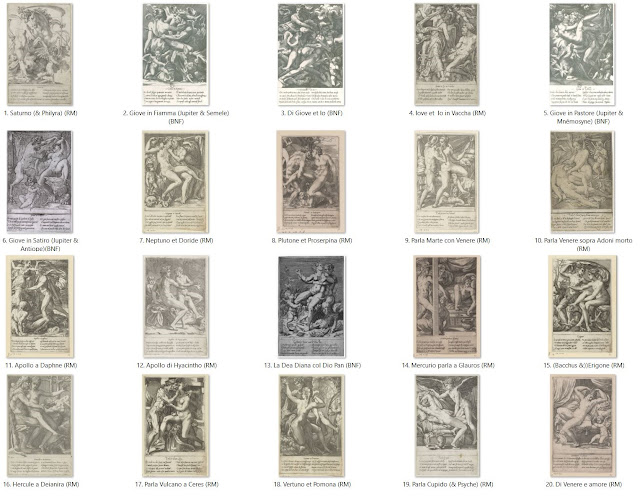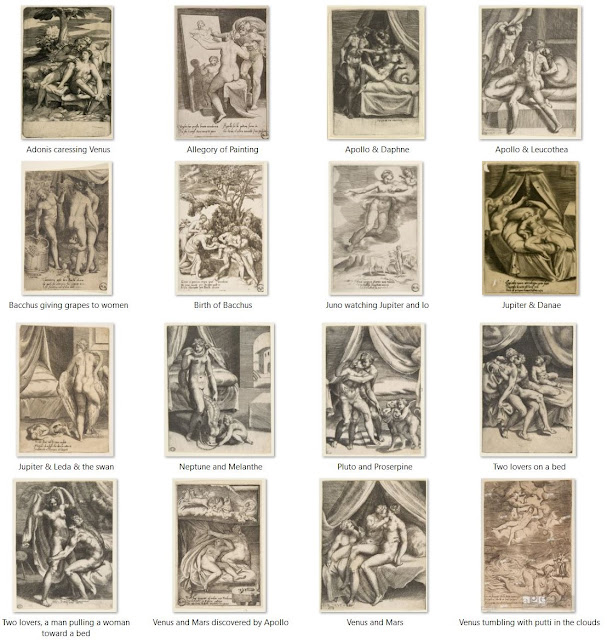The Italian Renaissance Nude amended (III)
The afterlife of ‘Loves of the Gods’
Baviero de’Carrocci, known as Il Baviera, the dynamic and trusted manager of RAFFAELLO’s workshop, needed money in the disastrous year 1527 of the ‘Sack of Rome’ and published a new series of dazzling erotic engravings, inspired from his stock of drawings and designs … with guaranteed commercial success among the soldiery (1 p.223).
The workshop had created earlier a series of sixteen very innovative naturalistic depictions of male and female bodies in intercourse positions, known as ‘I Modi’ (‘The Positions’), but the originals had been destroyed and its engravings seized in 1524 or 1525. To avoid censorship and ruin once more, this time each image got a clear mythological connotation with an associated title and text. The new series was now called ‘Amori degli Dei’ (Loves of the Gods) and engraved by Jacopo CARAGLIO. The success was extensive and the whole series or separate images were copied repeatedly and adapted or imitated with long textual descriptions. The images were also inspiration for frescoes, paintings, tapestries, ceramics (majolica), etc.
The foregoing post of January 31, 2019 „The Italian Renaissance Nude amended (II): mapping the story of ‘I Modi’ (‘The Positions’)“ presented the primary actors of both ‚I Modi‘ and ‚Loves of the Gods‘ and included reference to the notorious ‚Sonetti lussoriosi‘ of Pietro Aretino, illustrated with crude repetitions of ‚I Modi‘ by an anonymous artist of the 16th century (2). In the present post, the afterlife of ‚Loves of the Gods‘ is examined in chronological order. The afterlife of ‚I Modi‘ and the illustrations of Aretino’s ‚Sonetti‘ will be considered in the fourth post in this series of ‚The Italian Renaissance Nude amended‘, a quantitative approach to some subjects discussed by Jill Burke in her monograph (2).
‘Loves of the Gods’ and its imitators
Several of CARAGLIO’s engravings of 1527 were inspired by those of ‘I Modi’ but the addition of allegorical symbols or the ‚metamorphosis‘ (following Ovid’s poem) of a human into a mythical non-human form in the compositions made them more acceptable to the Church authorities. Thus the original human ‘joie de vivre’ expressed in the ‘The Positions’ was replaced by a mythological story-telling with titles and verses at the bottom.
 |
| CARAGLIO’s set of 20 engravings |
No complete set of presumably 20 images in the original edition of CARAGLIO is known. The Rijksmuseum in Amsterdam (RM) shows a set of 15 (4). The illustration above features this RM series and 5 more images from a later edition in the Bibliothèque Nationale de France (BNF). They are ordered according to the numbers centred beneath the image above the title in the BNF edition (5 Vol II).

Giulio BONASONE (1488-c1574) published around 1545 another series of engravings, now entitled ‘Amorosi diletti degli Dei’ (Loves of the Gods), clearly influenced by CARAGLIO’s engravings, but without depicting explicit intercourse positions between the mythological figures (6 p.193 ff).
 |
| ‘Amorosi diletti degli Dei’ 16 engravings by BONASONE |
Many images of both CARAGLIO and BONASONE were soon copied in France: by René BOYVIN (c1530-c1598) or by Pierre MILAN (active 1542-1557) and Jacques ANDROUET du CERCEAU (c1510-c1585) with translated titles and verses in French (7 p.139 ff) .
The series of CARAGLIO became also known in England. John SMITH (1652-1743) made in 1708-09 a series of mezzotints ‘Loves of the Gods’ after paintings, thought to be by TIZIANO in Blenheim Palace, Oxfordshire, destroyed by fire in 1861. Nine were copied by Pieter VAN GUNST in Amsterdam and published in 1710-14 by Pierre Drevet in Paris. The comparison with the engravings of CARAGLIO makes it clear that the reference to TIZIANO was fake.

 In 1833 the publisher Audot in Paris launched a bilingual album ‚Les Amours des Dieux – The Loves of the Gods‘ with the subtitles ‚d’après TITIEN, Annibal CARRACHE, et Jules ROMAIN – from TITIANO, Annibale CARACCI, and Giulio ROMANO‘ – ‚drawn and etched on steel by REVEIL with descriptive and historical notices by Duchesne Senior‘ (9). Here the text is not poetic but informative about the ‚Gods and their loves‘ with reference to the original paintings and former engravings by French and English artists. The image ‚Mars and Venus‘ is the one by John SMITH and thus falsely attributed to TIZIANO, as are several other paintings from the Blenheim Palace. His famous ‚Venus of Urbino‘ (here entitled ‚Vénus couchée‘, n°1032 in the illustration shown below) is surprisingly included. Several images represent frescoes by Annibale CARRACCI from the Galleria Farnese in Rome (as a whole sometimes called ‚Loves of the Gods‘). The first image in the illustration shown below is incorrectly entitled ‚Enée et Didon‘, curiously after an erratum of the previous, also incorrect, title ‚Vénus et Enée‘ (10).
In 1833 the publisher Audot in Paris launched a bilingual album ‚Les Amours des Dieux – The Loves of the Gods‘ with the subtitles ‚d’après TITIEN, Annibal CARRACHE, et Jules ROMAIN – from TITIANO, Annibale CARACCI, and Giulio ROMANO‘ – ‚drawn and etched on steel by REVEIL with descriptive and historical notices by Duchesne Senior‘ (9). Here the text is not poetic but informative about the ‚Gods and their loves‘ with reference to the original paintings and former engravings by French and English artists. The image ‚Mars and Venus‘ is the one by John SMITH and thus falsely attributed to TIZIANO, as are several other paintings from the Blenheim Palace. His famous ‚Venus of Urbino‘ (here entitled ‚Vénus couchée‘, n°1032 in the illustration shown below) is surprisingly included. Several images represent frescoes by Annibale CARRACCI from the Galleria Farnese in Rome (as a whole sometimes called ‚Loves of the Gods‘). The first image in the illustration shown below is incorrectly entitled ‚Enée et Didon‘, curiously after an erratum of the previous, also incorrect, title ‚Vénus et Enée‘ (10).
 |
| 18 engravings by Etienne Achille REVEIL (1800-1851) |
As could be expected, Jupiter is the most ‚active‘ with 9 different compagnions in the three series, followed by Venus and Apollo, both with 4 compagnions, Bacchus with 3 compagnions, etc.
| |
| ‚Gods in Love‘ in 54 images of CARAGLIO, BONASONE and REVEIL |
‚Loves of the Gods‘ also in the Sister Arts
Two examples:
* a literary work ‚Les Amours des Dieux‘ by De La Serre, published in 1629 without illustrations
* ‚Les Amours des Dieux, ballet héroïque‘ représenté pour la 1re fois par l’Académie royale de musique le mardy 16e septembre 1727
paroles de L. Fuzelier, musique de Jean-Joseph Mouret
NOTES
(1) Chastel A (1984) ‚Le sac de Rome, 1527 – du premier Maniérisme à la Contre-réformation‘. Gallimard, Paris. 369 pp., p.223: „…continuer sa production après mai (1527), c’est pour la soldatesque qu’il a alors utilisé ses cuivres.“
(2) See post of January 31, 2019 „The Italian Renaissance Nude amended (II): mapping the story of ‘I Modi’ (‘The Positions’)“
(3) Burke J (2018) ‘The Italian Renaissance Nude’. Yale University Press, New Haven and London. 2018, 240 pp.
(4) A search ‘Caraglio’ in Rijksstudio of the Rijksmuseum, Amsterdam, yields 53 works. There are two copies of n° 10 ‘Venus and Adonis dying’ in the series ‘Loves of the Gods’.
(5) Dunand, Louis et Lemarchand, Philippe: ‚Les Amours des Dieux – L’art érotique sous la Renaissance‘ . Institut d’Iconographie Arietis/Michel Slatkin, Lausanne/Genève. *Volume I Les compositions de Jules Romain, gravées par Marc-Antoine Raimondi. 1977, pp i-x, 11-384, figs 1-778 . *Volume II Les compositions de Titien, gravées par Gian-Jacopo Caraglio, selon les dessins préparatoires de Rosso Fiorentino et Perino del Vaga. 1989, pp. 385-736, figs 779-1203. *Volume III Les compositions de Augustin Carracci, gravées par Pierre de Jode l’Ancien : Le Lascivie. 1990, pp.736-1088, figs 1204-1658.
(6) Massari S (1989) ‚Tra Mito e Allegoria – Immagini a stampa nel ‚500 e ‚600 ‚. Istituto Nazionale per la Grafica – Sistemi Informativi S.p.A. Roma. 591 pp.
(7) Talvacchia B (1999) ‘Taking Positions – On the Erotic in Renaissance Culture’. Princeton University Press, Princeton New Jersey, 302 pp.
(8) See the Google Album ‚Venus and Mars making love (a selection of 72
artworks from 1528 to 2005)‘ in post of February 21, 2017 „Distant Viewing (6): Make love, not war“
(9) Les amours de dieux d’après Titien, Annibal Carrache et Jules Romain – gravés à l’eau-forte sur acier par Etienne Achille Réveil, avec des notices par Jean Duchesne ainé. Paris, Audot Editeur 1833. Books on Google Play eBook free.
(10) The frescoes of the Galleria Farnese in Rome are often called ‚Loves of the Gods‘. Most of them are inspired by Ovid’s ‚Metamorphoses‘. See post of September 21, 2013 ‚The one-night stand of a Goddess with consequences‘ and Comment of 11 February 2016.
Link to the original article here.
back